Although I hold a driving license and I used to drive regularly (whilst still living in Germany it was unavoidable), nowadays I am not too keen on driving for hours anymore, especially if it involves getting myself a rental car. So, when I am out and about during my business trips I will either try and hitch a ride with my clients or I might opt for the train. Well, provided I get a decent connection, nothing worse than an endless journey through Germany. In terms of trains, ICE travel in Germany is my favourite, as it is usually the quickest way to get from A to B.
Germany has a decent network of high-speed trains, called ICE (nope, not ‘In Case of Emergency’, ICE stands for Inter City Express), connecting all major cities in Germany.
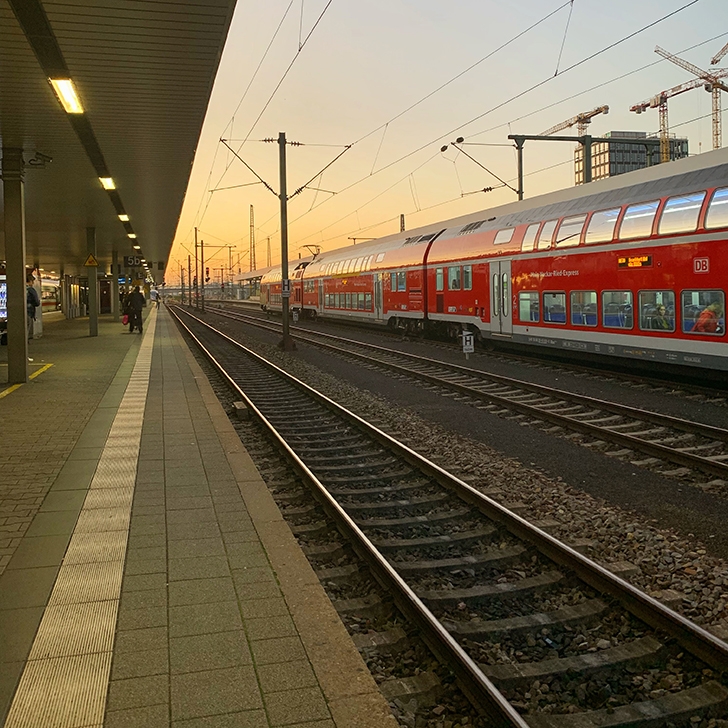
Depending on route, the ICE runs with a top speed of 320 km/h (200 m/h), meaning you might be better off taking the train than attempting to drive.
Take the route from Mannheim to Hamburg as an example: The quickest ICE connection takes a mere 4 hours 19 minutes. On the road, this journey is almost 600km, taking a good 6 hours (traffic permitting, plus breaks).
Can you see why I would favour ICE travel in Germany? Much quicker and with the added benefit of getting some work done whilst travelling. Or catching up on sleep (if your day already started with an early morning flight to Germany for example).
So next time rather than planning a road trip, why not check the ICE travel connections in Germany?
In this post I will tell you:
- How to book tickets for the ICE
- What tickets are available on the ICE
- How to get the best price for ICE train travel in Germany
- Whether to reserve a seat on the ICE or not
- How to board an ICE train correctly
- What’s it like onboard an ICE train
Obviously, I am not saying the ICE travel through Germany is the best thing ever. It can be unreliable at times, with delays mounting. And if things go wrong (for me), they tend to go wrong big time. But for most of the time I am lucky, and things go well.
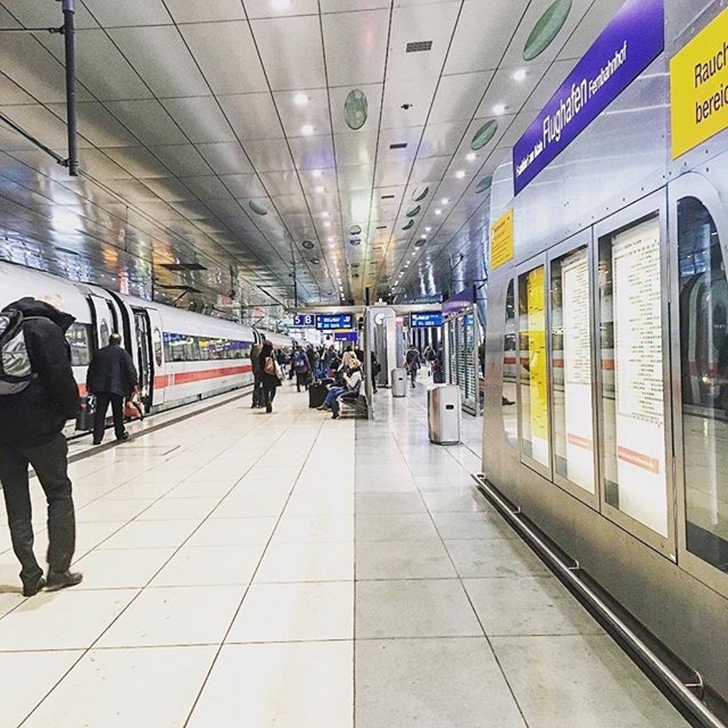
How to book tickets for the ICE? And what tickets are available?
OK, if you are considering giving ICE travel in Germany a try, this would probably be the first step. Getting yourself a ticket. So how best to do this?
Well, there are several options.
You could go proper old school, go to a train station in Germany and buy your ticket at the counter. Which is great for last minute trips. But probably not very convenient if you want to get your ICE travel in Germany all mapped out and booked before arriving in Germany.
Easier option would then be to book your tickets online. Either via the Deutsche Bahn website or through their DB Navigator app on your smartphone.
Booking your ICE ticket online works fairly well and is my preferred method of booking. Both the website and the app are available in English language, so even if you don’t speak any German, you should be fine booking your tickets. In the past, there were some issues with language (somewhere along the line during the booking process it would revert back to German), but I believe these have been sorted now.
Regardless of whether you book online or at a ticket office, you can book tickets up to six months in advance.
If you have a smart phone, I would always recommend signing up and using the app. As it is not only a means to book your ticket. It also stores your ticket and route details, so that you don’t have to carry any print outs with you. Even if you book via the website, the ticket will automatically transfer to your app.
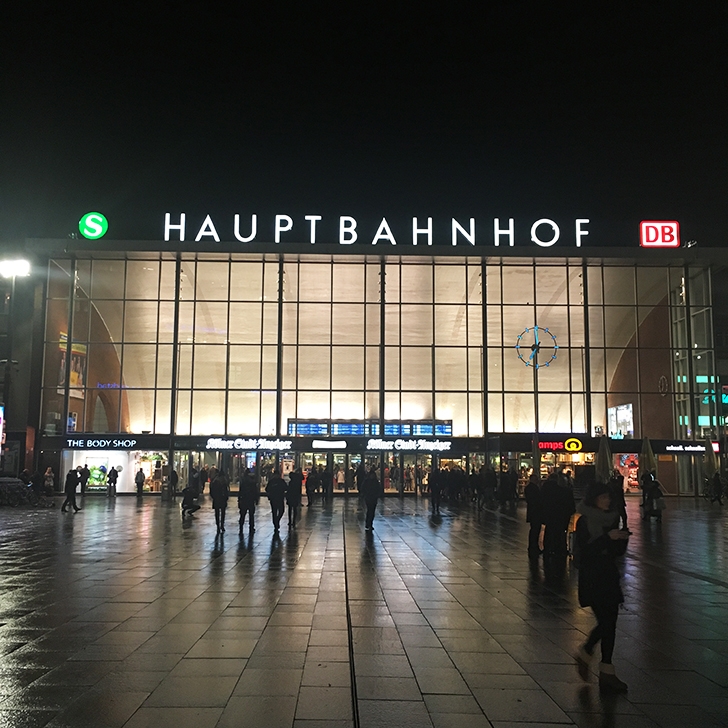
When booking a ticket for ICE train travel through Germany, you have several ticket types to choose from. And the type of ticket will ultimately determine the price of your travel. So, before I tell you how to get the best price for your ICE travel, let me explain to you the six tickets available (three each for second and first class):
Super Sparpreis (Super Saver Ticket)
This second-class ticket is usually the cheapest one you can find. It is only available if you book in advance, not on the day. You’ll have to pick a specific train and you won’t be able to change or cancel your ticket.
Sparpreis (Saver Ticket)
Next one up is the Saver Ticket. Similar to the Super Saver, this is only available if booked at least a couple of days in advance. You will have to pick a specific train; however, this ticket can be cancelled before the travel (although you won’t get your money back, you will only get a travel voucher, minus a 10 EUR fee). The Saver Ticket includes a city ticket, enabling you to use public transport in the city you depart and arrive.
The Saver Ticket is usually marginally more expensive than the Super Saver.
Flexpreis (Flexible Ticket)
As the name suggests, this ticket gives you the greatest flexibility for your ICE travel through Germany. Although you pick a train when booking your ticket, you can just board any other train on that route on the day. And you have the option of cancelling your ticket free of charge before the day (or even on the day for a fee of 19 EUR). Same as the Saver Ticket, the Flexible Ticket includes a city ticket for both your departure and arrival city.
Unfortunately, this flexibility comes at a price. The Flexible Ticket can easily be double the price to the Saver Ticket, even though it is still a second-class ticket.
If you book your ticket last minute (on the day or a day before), the flexible ticket might be the only one available.
Super Sparpreis 1st Class (Super Saver 1st Class)
When booking well in advance, you might find that the Super Saver 1st Class isn’t much more expensive than the 2ndClass Saver Ticket. And often cheaper than the flexible. However, same as with the standard Super Saver Ticket, your ticket is only valid for a specific train and cannot be cancelled. It does not include a City Ticket, nor does it allow access to the DB lounge. But it does include a reserved seat on the train (which in second class costs an additional 4.50 EUR).
Sparpreis 1st Class (Saver Ticket 1st Class)
As with the Saver Ticket for second class, the first class one is for a specific train, but can be cancelled until the day before your trip (for a fee and in exchange for a travel voucher, not your money back). The Saver Ticket includes a City Ticket. But even though it is a first-class ticket, it does not include access access to the DB lounge.
The Saver Ticket is usually only marginally more expensive than the Super Saver Ticket. And might not be much more than the 2nd class equivalent, if bought well in advance. And it already includes a reserved seat.
Flexpreis 1st Class (Flexible Ticket 1st Class)
This is the most expensive ticket available for your ICE travel through Germany. But it also gives you the greatest flexibility. You have an unrestricted choice of trains on the day of your travel. You can cancel your ticket free of charge until the day before. The Flexible Ticket includes a City Ticket, plus access to the DB lounge, plus a reserved seat.
But it might easily be two to three times the price of the 1st Class Saver Ticket.
Again, if booking last minute / on the day, the Flexpreis Ticket might be the only one available, so bear that in mind when planning your ICE travel in Germany.
How to get the best price for ICE train travel through Germany
Does this all sound really complicated? Well, don’t worry, it actually isn’t that bad, once you get used to it. When you select your route and date on the Deutsche Bahn website (or app), it will show you the available options.
As already mentioned, the earlier you book, the better the price usually. Also, the more you commit, the cheaper it gets. Meaning, if you know for sure what time of day you’ll be leaving, you might decide to go for a Super Saver or Saver Ticket. Saving you money on your ICE travel.
Taking the ICE during my business travels through Germany, I often book a Saver Ticket when leaving my parent’s home or a hotel in the morning, ahead of my meetings. Since I know what time my meeting is, I can easily commit to a specific train and time. The reason I’d usually go for the Saver rather than Super Saver is the added option of cancellation. As there is always a chance that my business trips are cancelled or the route changes ahead of the trip. And since the price difference between Super Saver and Saver Ticket isn’t much, I’d rather keep the cancellation option.
However, to head to the airport after a meeting or when taking an ICE train directly from the airport, I will usually opt for the flexible ticket. As I don’t always know how long my meetings will last. Or if my flight might be delayed and I would therefore arrive too late for my booked train. In such instances, flexibility makes life a lot easier for me, albeit at a slightly higher price. Nothing worse than missing your train by five minutes (and believe me, been there done that numerous times).
Whenever taking the ICE for leisure, be it a day trip to Nuremberg for the Christmas market or to go and visit friends, I aim to book a Saver Ticket and therefore commit to a fixed train. That being said, if booking early, I might actually spend that little bit extra and upgrade to a 1st class Saver Ticket. As mentioned before, the price difference can be miniscule. And once you add the benefits of First-Class train travel (reserved seating, free Wifi and a coffee during your journey), it could be well worth it. Or at least it is worth it for me.
If you opt for a Flex ticket, it does give you the option of breaking up your train travel and spending an hour or two in a city along the route before continuing with your trip. Take Berlin as an example. It might not be part of your actual trip, but there’s a lot you can do in Berlin in an hour or two.
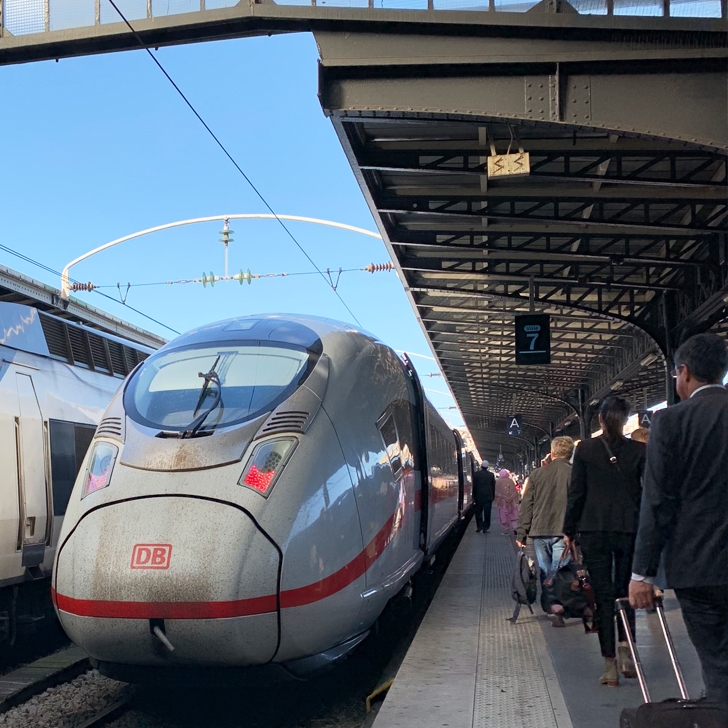
BahnCard 25, 50 and 100
If you are planning an entire tour and know you are going to book several tickets for ICE travel in Germany, it might be worth you looking into the option of getting yourself a BahnCard. When it comes to getting the best price for your ICE travel, this can be a really good way to save money. Provided you do enough trips.
So, what is the BahnCard and how does it work?
The BahnCard is a discount card offered by Deutsche Bahn, that you can buy for a year and that will give you discount on all your ICE tickets.
There are three different BahnCards available. The BahnCard 25 offers a 25% discount on all tickets, the BahnCard 50 a 50% discount. And the BahnCard 100 (can you guess?) allows for train travel completely for free. But if you only travel by ICE once in a blue moon, a yearly BahnCard might not be worth it, as the discount for your ICE travel through Germany might be lower than the cost of the BahnCard. But don’t despair. Deutsche Bahn actually offers a 3-month trial BahnCard at a considerably lower price. If you are planning a longer Germany trip, this might just work for you (although please remember that your BahnCard needs to be active when you travel. Meaning, you can’t book six months in advance with a 3month trial BahnCard).
A BahnCard 25 currently costs 55.70 EUR for 12 months. Depending on the price of your ICE ticket (or if you are booking several tickets), a BahnCard 25 would have paid for itself, once the complete cost of your ICE ticket(s) goes above 223 EUR.
Should I reserve a seat when taking the ICE?
Well, whether or not you reserve yourself a seat for your ICE travel through Germany is entirely up to you. For most journeys you don’t have to book a seat.
A seat reservation costs 4.50 EUR per journey. That’s from start to finish, not per train. Even if you have to change trains along the way, you will only have to pay the fee once.
I tend to book myself a seat when travelling on the ICE, mainly because I like my comfort. Nothing worse than standing in the aisle for hours. That being said, if it is a short journey, I won’t bother. The ICE journey from Frankfurt Airport to Mannheim (the nearest ICE station to my parents) takes 30 minutes. No way would I waste 4.50 EUR for this journey. Worst case scenario, I will just stand. But if my ICE travel through Germany takes several hours, I will make sure I reserve myself a seat.
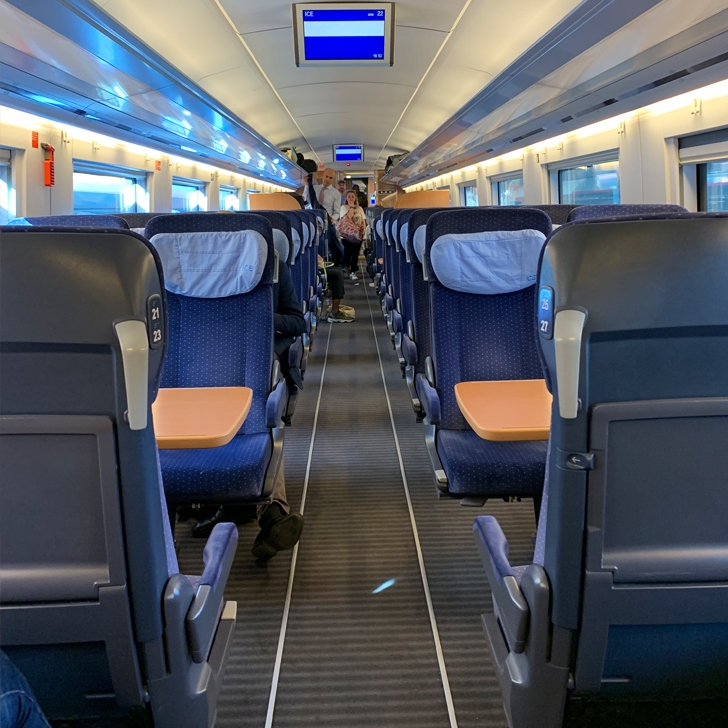
How do you book a seat on the ICE?
When you book your train ticket, you can book a seat straight away. Which makes sense if you have a Saver Ticket or Super Saver Ticket, where you booked a fixed train journey. If you have booked a Flexible Ticket, this isn’t quite as straight forward. Yes, you can go ahead and book a seat. But who knows if you are actually going to take that specific train? Up to you now, how you’d like to proceed. Deutsche Bahn allows you to make up to three seat reservations for each Flexible Ticket. So, if you are unsure which train you will take exactly, you could book seats on the three most likely train connections. But you will obviously have to pay for each and every one of those reservations. And seat reservations are non-refundable.
Alternatively, you can leave the seat reservation and gamble and hope for the best when boarding the train. Or you book your seat last minute, once you have a better idea which train you are actually going to take. Which is, when the DB app comes in very handy. As it allows you to book a seat on the go, quick and easy.
My personal approach to seat reservations on flexible tickets? I will often book a seat on the train I am most likely to take (or on the most convenient and ideal connection I would like to take). If I miss it, not the end of the world, I will book another seat on the next train. If I show up at the station early, I make a judgement call. Is it worth boarding an earlier train (and paying for another seat reservation)? Or is the connection so much better that I would rather wait a little at the station and take the one originally booked? Well, that also depends whether we talk an hour wait time or three.
How to board the ICE train correctly?
As you arrive at the station, check which platform your ICE departs from. Actually, unless there is any major problem at said station, this info can also be found on your ticket. ICE trains have fixed platforms at each station.
Once on the platform, check for the ‘Wagenreihungsplan’ (Coach Sequence Indicator): An information board on each platform, that lists all the ICEs departing from this platform. This will tell you exactly, which section of the platform you will need to stand in, so that you can board the correct coach of your ICE.
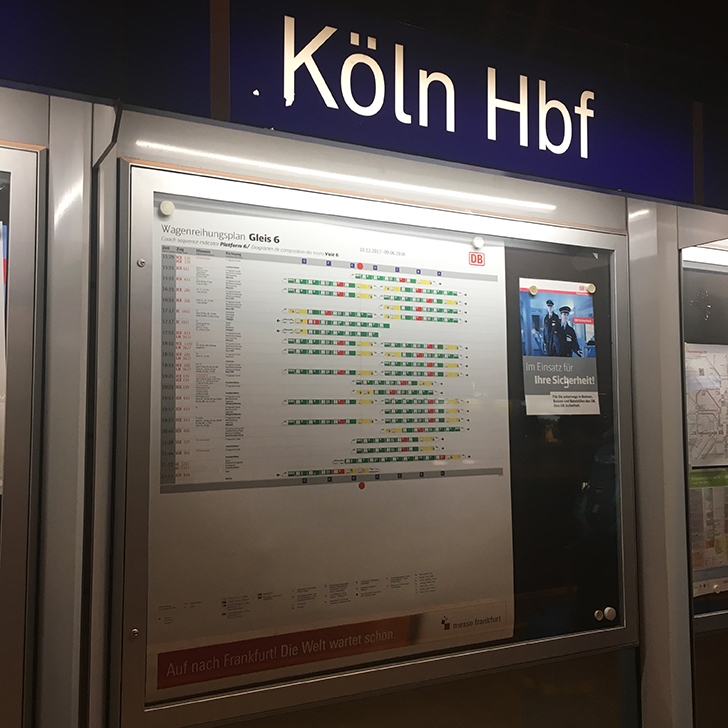
Unlike the Eurostar between London and Paris for example, ICE trains consist of two separate parts. If you accidentally board the wrong part of the train, you will not be able to get to the other half of the train until it reaches its next stop. Which is very annoying if your reserved seat is in the other half.
Once on board and in the right coach, check for your seat number. A little display above the seat (or at the side of the seat in newer ICE models) will show you the seat number and reserved route.
If you board an ICE without a seat reservation, these displays will help you find an empty seat. Although a seat might be reserved further down the route, if it is vacant until then, you can sit there. But you will have to vacate it once a traveller with seat reservation claims it.
If you are using the DB app, rather than waiting for the train conductor to come and check your ticket, you can check yourself in via the app. Just confirm the seat you are and complete the self-check in. No need for anyone to disturb you during the journey, just to check your ticket.
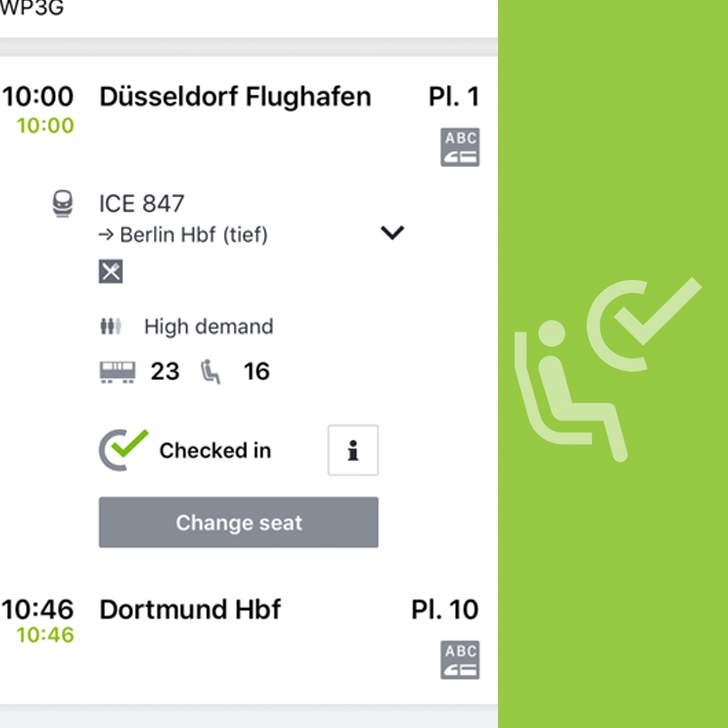
What’s it like onboard an ICE train?
OK, now that we’ve covered all angles of booking ICE tickets and boarding the train, how about I tell you a little what to actually expect inside an ICE train?
As the ICE is designed for high-speed, long-distance train journeys through Germany, the ICE is all about comfort and convenience.
You have a choice of coach layouts and seating styles. In the open coaches, there are rows of two with foldable tables in front. And groups of four facing each other, with a table in the centre.
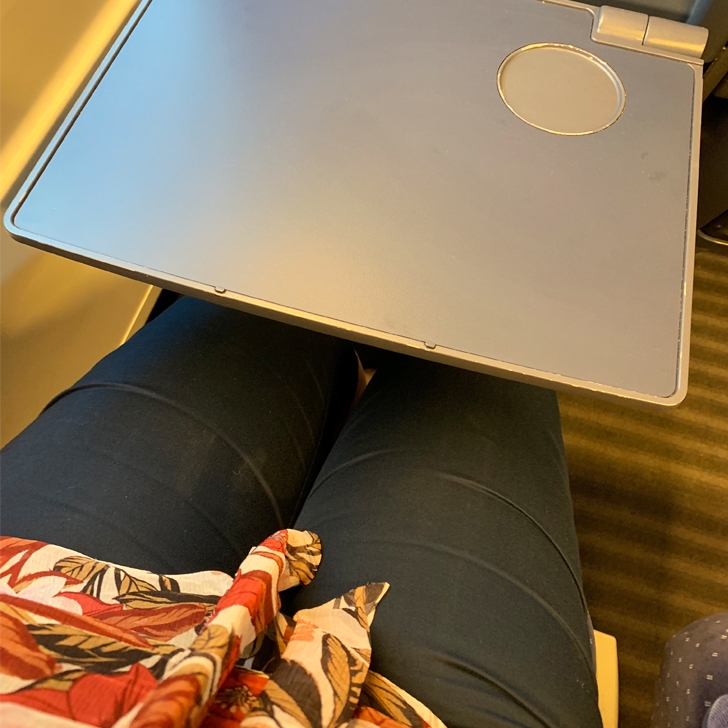
Then you have the individual compartments. Groups of six seats (three either side, facing each other), with a small table by the window and luggage storage above the seats.
Personally, I prefer the open coach layout to the compartments. Especially if the train is packed, sharing a compartment with five other strangers can feel rather crowded. If you are trying to work, the lack of table also isn’t ideal.
All seats come with in-seat power, although you do usually have to share one European socket between two seats.
WIFI is available on board the ICE, but it is fairly basic speed and to be honest, rather patchy at times. The one available in 1st class (or for purchase in 2nd class) is a little better. But with little to no phone reception / mobile internet due to the speed the ICE is moving you aren’t spoiled for choices, I’m afraid.
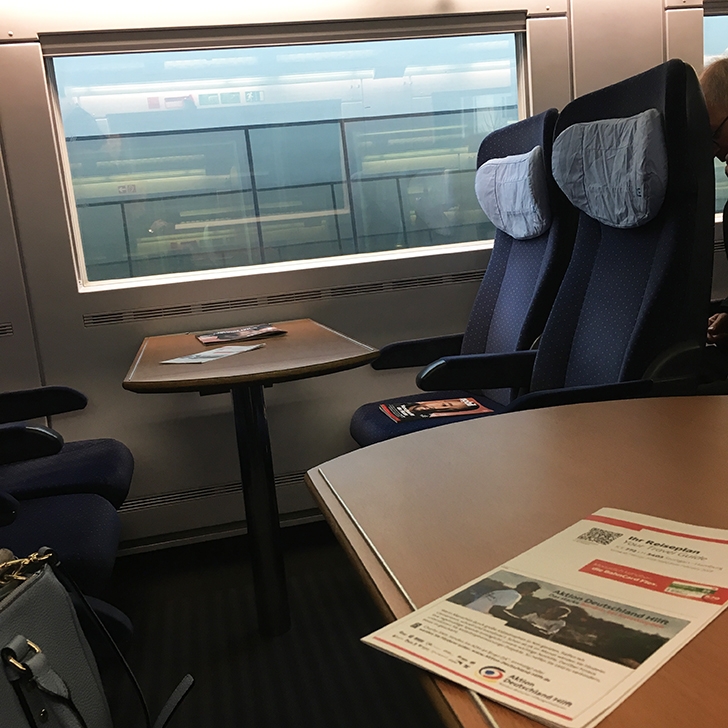
OK, there you have it. My rather lengthy guide on ICE travel through Germany. I hope I didn’t completely bore you to death and you find it at least a tiny little bit helpful.
Tell me, have you travelled on the ICE? How does it compare to high-speed trains in other countries?

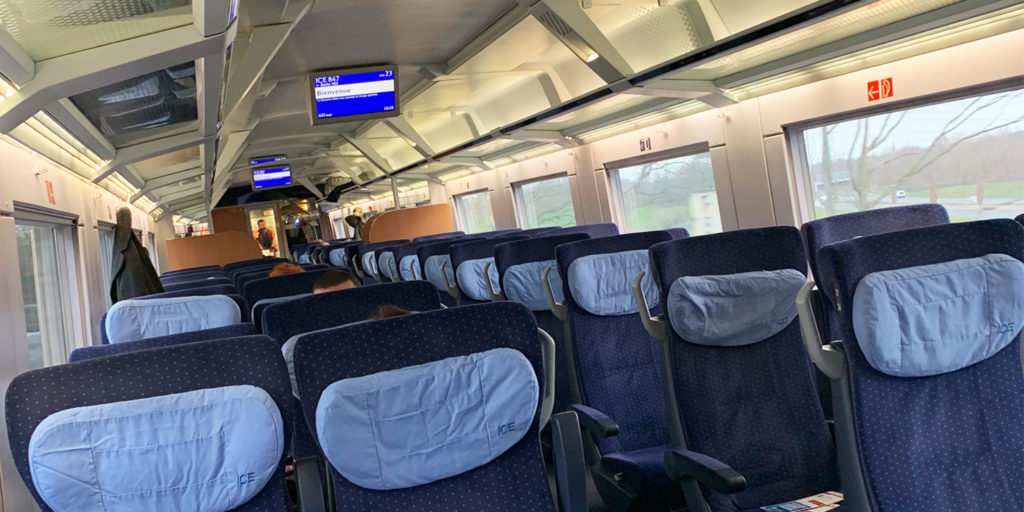
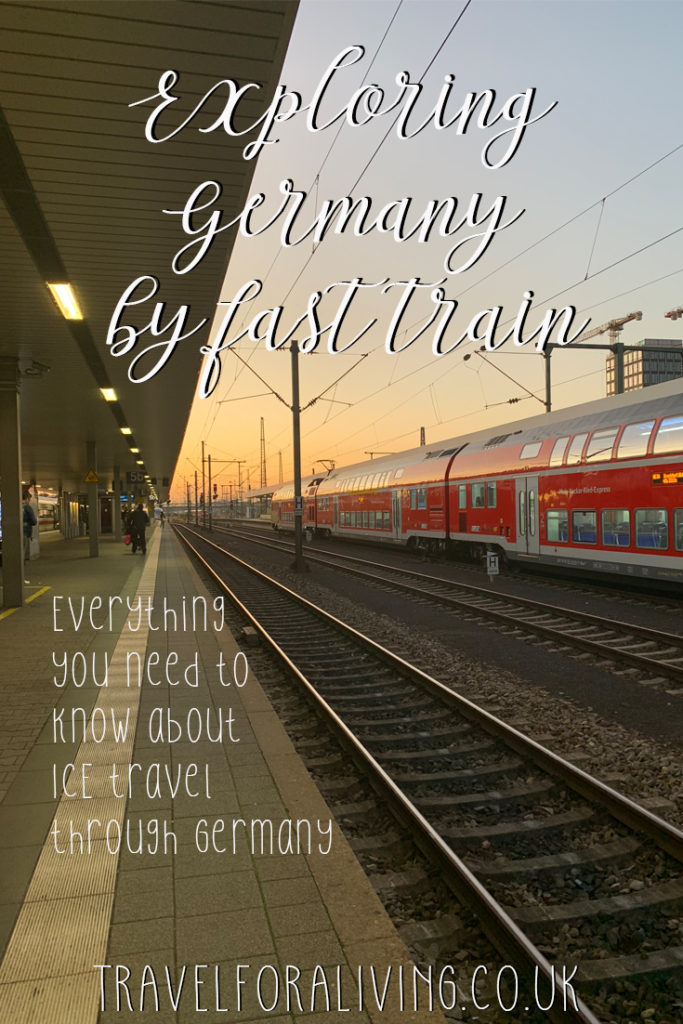
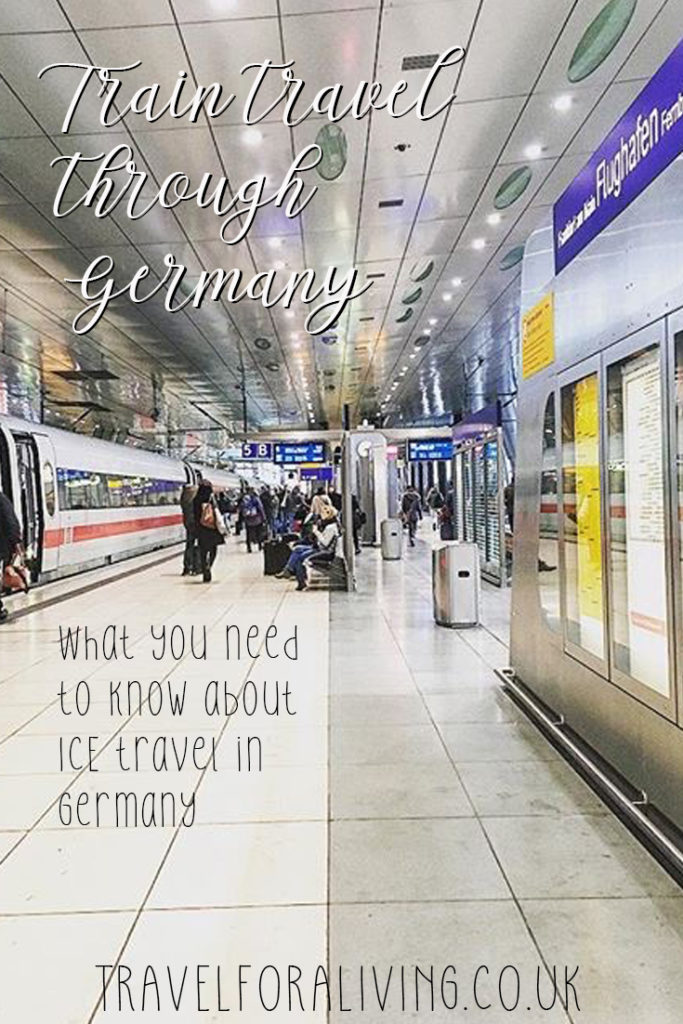
Ciara
Wow, this is an insane amount of information. I feel confident about using the ICE system when I visit, thanks so much!
Get Lost
This is a great guide! Normally when I visit somewhere, I only visit one city and don’t really think about getting a train to see other places. From my experience so far, public transport in Germany has always been really easy to navigate, so next time I visit I’ll come back to your guide and look at visiting a couple of cities in one trip. Thanks for the inspiration!
jetlaggedroamer
I fell in love with Germany when visiting Munich. Would love to explore more of Germany and this looks like a great way. Thank you for the information!
RideTransferdirect
Amazing! I know nothing about traveling all over the country, what a wonderful looking place to explore.
PlacesofJuma
Thank you so much for the many fantastic tips!